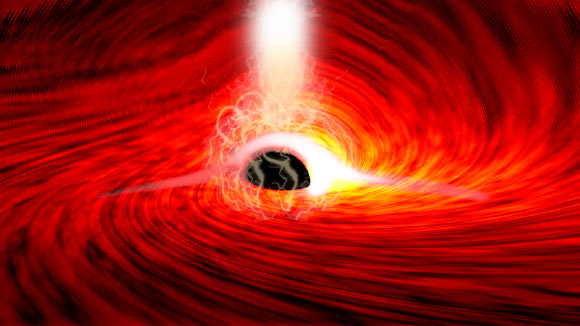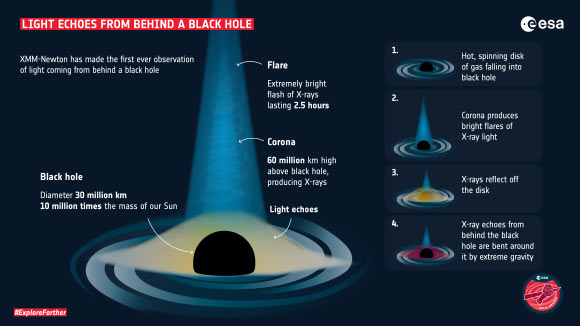Using ESA’s XMM-Newton and NASA’s NuSTAR space telescopes, astronomers have observed X-ray flares emitted from around the supermassive black hole in a nearby galaxy called I Zwicky 1 (I Zw 1); further analysis of the flares has revealed short flashes of photons consistent with the re-emergence of emission from behind the black hole; these are photons that reverberate off the far side of the black hole’s accretion disk, and are bent around the black hole and magnified by the strong gravitational field.

Wilkins et al. observed bright flares of X-ray emissions, produced as gas falls into a supermassive black hole in I Zwicky 1; the flares echoed off of the gas falling into the black hole, and as the flares were subsiding, short flashes of X-rays were seen — corresponding to the reflection of the flares from the far side of the disk, bent around the black hole by its strong gravitational field. Image credit: Dan Wilkins.
I Zw 1 is located approximately 800 million light-years away in the constellation of Pisces.
Otherwise known as Mrk 1502 or LEDA 3151, it is classified as a Seyfert 1-type galaxy.
It hosts a supermassive black hole about 10 million times massive than our Sun.
The astronomers did not expect to see anything from behind the black hole, since no light can escape from it.
But because of the black hole’s extreme gravity warping the space around it, light echoes from behind the black hole were bent around the black hole, making them visible from XMM and NuSTAR’s point of view.
“Any light that goes into that black hole doesn’t come out, so we shouldn’t be able to see anything that’s behind the black hole,” said Dr. Dan Wilkins, a researcher at the Kavli Institute for Particle Astrophysics and Cosmology at Stanford University and SLAC National Accelerator Laboratory.
“The reason we can see that is because that black hole is warping space, bending light and twisting magnetic fields around itself.”
The discovery began with the search to find out more about the mysterious ‘corona’ of the I Zw 1’s black hole, which is the source of the bright X-ray light.
Astronomers think that the corona is a result of gas that falls continuously into the black hole, where it forms a spinning disk around it. This gas disk is heated up to millions of degrees and generates magnetic fields that get twisted into knots by the spinning black hole.
When the magnetic field gets tied up, it eventually snaps, releasing the energy stored within it. This heats everything around it and produces the corona of high energy electrons that produce the X-ray light.
The flare observed from I Zw 1 was so bright that some of the X-rays shone down onto the disk of gas falling into the black hole.
The X-rays that reflected on the gas behind the black hole were bent around the black hole, and these smaller flashes arrived at the telescopes with a delay.
These observations match Albert Einstein’s predictions of how gravity bends light around black holes, as described in his theory of general relativity.
“Fifty years ago, when astrophysicists starting speculating about how the magnetic field might behave close to a black hole, they had no idea that one day we might have the techniques to observe this directly and see Einstein’s general theory of relativity in action,” said Professor Roger Blandford, also from the at the Kavli Institute for Particle Astrophysics and Cosmology at Stanford University and SLAC National Accelerator Laboratory.
A paper on the findings was published in the journal Nature.
_____
D.R. Wilkins et al. 2021. Light bending and X-ray echoes from behind a supermassive black hole. Nature 595, 657-660; doi: 10.1038/s41586-021-03667-0








